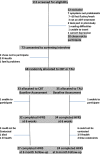A randomised controlled trial of a brief cognitive behavioural intervention for men who have hot flushes following prostate cancer treatment (MANCAN)
- PMID: 25753889
- PMCID: PMC5006840
- DOI: 10.1002/pon.3794
A randomised controlled trial of a brief cognitive behavioural intervention for men who have hot flushes following prostate cancer treatment (MANCAN)
Abstract
Objective: Hot flushes and night sweats (HFNS) are experienced by up to 80% of prostate cancer patients undergoing androgen deprivation therapy (ADT). This study evaluates the effects of a guided self-help cognitive behavioural therapy (CBT) intervention on HFNS problem-rating (primary outcome), HFNS frequency, mood and health-related quality of life (secondary outcomes) in patients undergoing ADT.
Methods: Patients reporting treatment-induced HFNS were randomly assigned to CBT (n = 33) or treatment as usual (TAU) (n = 35), stratified for cancer type. The CBT intervention included a booklet, CD plus telephone contact during a 4-week period. Validated self-report questionnaires were completed at baseline, 6 weeks and 32 weeks after randomisation. The primary outcome was HFNS problem rating (perceived burden of HFNS) at 6 weeks after randomisation. Potential moderators and mediators were examined. Data analysis was conducted on a modified intention-to-treat basis.
Results: Compared with TAU, CBT significantly reduced HFNS problem rating (adjusted mean difference: -1.33, 95% CI -2.07 to -0.58; p = 0.001) and HFNS frequency (-12.12, 95% CI -22.39 to -1.84; p = 0.02) at 6 weeks. Improvements were maintained at 32 weeks, but group differences did not reach significance. There were significant reductions in negative HFNS Beliefs and Behaviours following CBT, but not in mood or quality of life.
Conclusions: Guided self-help CBT appears to be a safe and effective brief treatment for men who have problematic HFNS following prostate cancer treatments. Further research might test the efficacy of the intervention in a multicentre trial.
© 2015 The Authors. Psycho-Oncology published by John Wiley & Sons Ltd.
Figures



Similar articles
-
A multicentre randomised controlled trial of a guided self-help cognitive behavioural therapy to MANage the impact of hot flushes and night sweats in patients with prostate CANcer undergoing androgen deprivation therapy (MANCAN2).Trials. 2023 Jul 10;24(1):450. doi: 10.1186/s13063-023-07325-w. Trials. 2023. PMID: 37430353 Free PMC article. Clinical Trial.
-
Cognitive behavioural treatment for women who have menopausal symptoms after breast cancer treatment (MENOS 1): a randomised controlled trial.Lancet Oncol. 2012 Mar;13(3):309-18. doi: 10.1016/S1470-2045(11)70364-3. Epub 2012 Feb 15. Lancet Oncol. 2012. PMID: 22340966 Free PMC article. Clinical Trial.
-
Effectiveness of nurse-led group CBT for hot flushes and night sweats in women with breast cancer: Results of the MENOS4 randomised controlled trial.Psychooncology. 2020 Oct;29(10):1514-1523. doi: 10.1002/pon.5432. Epub 2020 Jul 24. Psychooncology. 2020. PMID: 32458473 Free PMC article. Clinical Trial.
-
Androgen deprivation therapy complications.Endocr Relat Cancer. 2014 Aug;21(4):T119-29. doi: 10.1530/ERC-13-0467. Epub 2014 May 28. Endocr Relat Cancer. 2014. PMID: 24872511 Review.
-
Cognitive behavioral therapy for menopausal symptoms.Climacteric. 2021 Feb;24(1):51-56. doi: 10.1080/13697137.2020.1777965. Epub 2020 Jul 6. Climacteric. 2021. PMID: 32627593 Review.
Cited by
-
Effectiveness of educational and psychological survivorship interventions to improve health-related quality of life outcomes for men with prostate cancer on androgen deprivation therapy: a systematic review.BMJ Open. 2024 May 22;14(5):e080310. doi: 10.1136/bmjopen-2023-080310. BMJ Open. 2024. PMID: 38777593 Free PMC article.
-
Multimedia-based hormone therapy information program for patients with prostate cancer: the result of a randomized pilot study.Sci Rep. 2023 Dec 27;13(1):23022. doi: 10.1038/s41598-023-50006-6. Sci Rep. 2023. PMID: 38155164 Free PMC article. Clinical Trial.
-
The effectiveness of lifestyle interventions to reduce side effects of androgen deprivation therapy for men with prostate cancer: a systematic review.Qual Life Res. 2020 Apr;29(4):843-865. doi: 10.1007/s11136-019-02361-z. Epub 2019 Dec 12. Qual Life Res. 2020. PMID: 31832978 Free PMC article.
-
A multicentre randomised controlled trial of a guided self-help cognitive behavioural therapy to MANage the impact of hot flushes and night sweats in patients with prostate CANcer undergoing androgen deprivation therapy (MANCAN2).Trials. 2023 Jul 10;24(1):450. doi: 10.1186/s13063-023-07325-w. Trials. 2023. PMID: 37430353 Free PMC article. Clinical Trial.
-
Comparing Interventions for Management of Hot Flashes in Patients With Breast and Prostate Cancer: A Systematic Review With Meta-Analyses.Oncol Nurs Forum. 2020 Jul 1;47(4):E86-E106. doi: 10.1188/20.ONF.E86-E106. Oncol Nurs Forum. 2020. PMID: 32555553 Free PMC article.
References
-
- Jemal A, Bray F, Center MM, et al. Global cancer statistics. CA: A Cancer J Clin 2011;61(2):69–90. - PubMed
-
- Grunfeld EA, Halliday A, Martin P, et al. Andropause syndrome in men treated for metastatic prostate cancer: a qualitative study of the impact of symptoms. Cancer Nurs. 2013;35(1):63–69. - PubMed
-
- Frisk J. Managing hot flushes in men after prostate cancer. A systematic review. Maturitas 2010;65(1):15–22. - PubMed
Publication types
MeSH terms
Substances
LinkOut - more resources
Full Text Sources
Other Literature Sources
Medical

